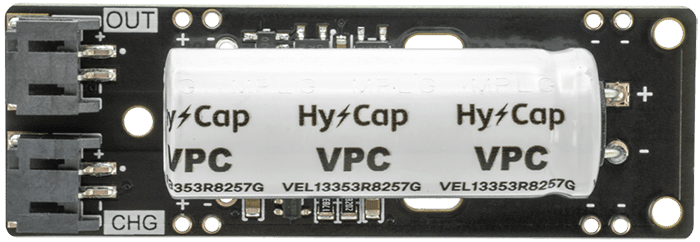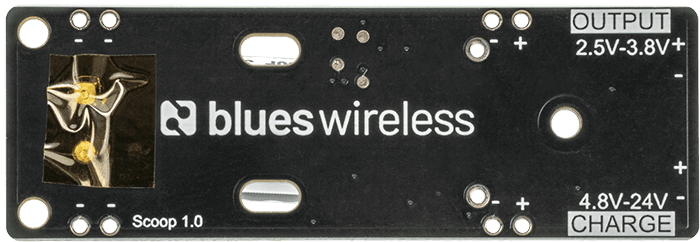Blues Scoop™ Datasheet
Functional Description
The Scoop provides backup power and facilitates reliable power management for Notecard-powered IoT applications. The Scoop includes a Lithium-Ion Capacitor (LIC), a hybrid type of capacitor classified as a type of supercapacitor. LICs have numerous advantages in comparison to using Lithium Polymer (LiPo) batteries as a power source as, in general, they are more reliable, have the ability to operate in a wider range of temperatures, experience a lower self-discharge rate, and are significantly safer to ship.
The Scoop includes a 250 Farads LIC, two JST connectors, and four pairs of header pins for flexible connectivity.


Features
- Capacitor: Lithium-Ion 250F 3.8V. Provides reliable power and stable delivery over a short period of time.
- Connectors: JST Battery Connectors PH-2POS wired for Adafruit-style packs.
- Charge Connector: J1, Accepts 4.8V-24V (see Board Errata below).
- Output Connector: J2, Outputs 2.5V-3.8V.
- Header Pins: 4 pairs of through-hole mounted male header pins.
 note
noteBased on internal testing, Scoop is able to power up to approximately 20 on/off cellular connection cycles, or up to 240 minutes of a single cellular connection. Results may vary depending the type of wireless coverage in the area and the amount and frequency of data being sent.
Power Information
The Scoop can be powered via its charge connector (CHG), which accepts an
input voltage of 4.8V-24V (see Board Errata below), or via the
adjacent header pins.
The output (OUT) connector can deliver a voltage in the range of 2.5V-3.8V.
Dimensions
The Scoop was designed with a minimal footprint for easy embedding in existing applications.
- 59.69mm (2.35 inches) wide
- 20.0mm (0.79 inches) tall
- 14.16mm (0.56 inches) deep
Header Pins
The Scoop features four pairs of header pins, labeled as follows:
- J3 header pair (next to
CHG): Power source - J4 header pair (next to
OUT): Load circuit
Board Errata
Serigraphy on the Scoop lists the input charge voltage as 4.8V-24V. However, if Scoop is connected to a Notecarrier F and is fully discharged, when a voltage >5V is subsequently applied, the LIC on the Scoop will not charge well. Additionally, the Notecard and host MCU attached to the Notecarrier F will not be able to run and may enter a boot loop.
This is due to a current draw limitation on the power converter on the Scoop that limits the current depending on the voltage differential across the power converter. For higher voltage levels, the input current draw is lowered enough so that the LIC takes a long time to charge, and will keep getting discharged by the Notecard while it attempts to power on.
